At the end of last year, IEA Bioenergy developed a report on biogas and biomethane production, the use of biogas and other anaerobic digestion products, political and financial conditions, as well as innovative projects in the member countries of the International Energy Agency (IEA). Previously, we looked at the main points of this report, and now we will focus in more detail on the state of the biogas industry in some Nordic countries: Finland, Norway, and Sweden.
Finland
Production and use
In 2021, the total recovered energy production from biogas was about 905 GWh from 129 different biogas production plants. Both the number of biogas plants and the amount of produced energy have increased in recent years. Upgrading of biogas into biomethane was carried out at 21 plants (156 GWh).
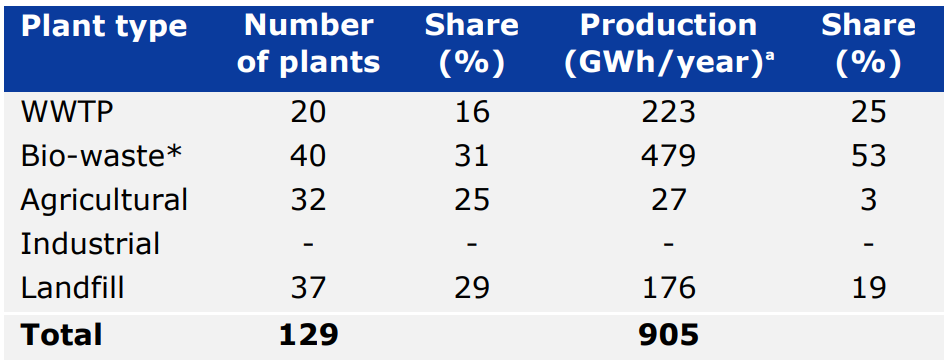
Biogas production in Finland (Statistics Finland, 2022). Source: IEA Bioenergy. Note: *co-digestion plants, including industrial plants.
In Finland, biogas has traditionally been used in power and heat production, but in recent years vehicle fuel use has increased. There are about 100 public fueling stations for biomethane/CNG and the number of gas-fueled vehicles is increasing, including heavy transport vehicles.
Support
The most important subsidies for biogas plants are three different investment support schemes. They vary according to the size of the biogas plant and the biogas use, and include:
- Investment support for large industrial plants.
- Investment support for farm own energy production.
- Investment support for agricultural companies.
The investment support for large scale industrial plants is provided by the Ministry of Employment and Economy. A maximum of 30% of the eligible investment costs are covered in this scheme. From 2020 onwards, special attention has been given to digestate processing and use. That is, even greater financial support can be obtained if there is a higher risk to economic profitability that results from digestate handling costs.
Norway
In Norway, 739 GWh of biogas was produced in 2022, representing a marginal increase of 4% since 2021. Seven new plants were built in this period, of which most of them are still in start-up phase. Biogas is mainly produced from sewage sludge and food waste.
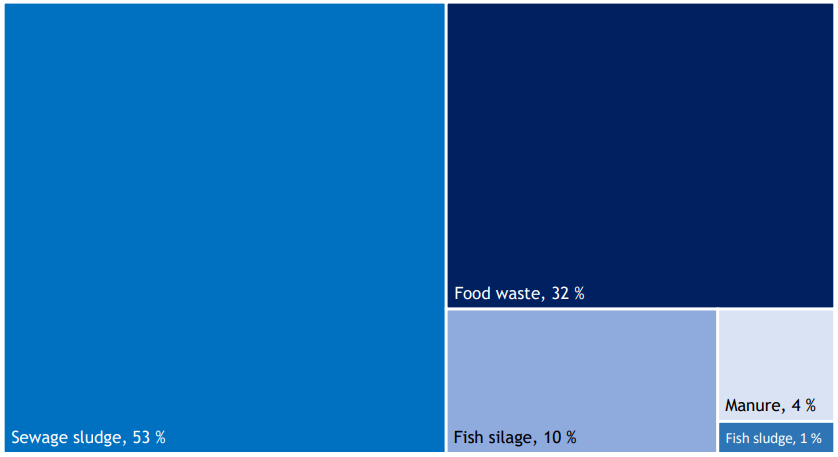
Relative shares of feedstock used for biogas production in Norway (per ton of dry matter) in 2022 (Norwaste, 2023). Source: IEA Bioenergy.
There were 56 biogas plants in Norway in 2022. Of the new biogas plants, five are agricultural and two are industrial. The number of wastewater treatment plants (WWTP) and bio-waste plants remains the same as in 2021.
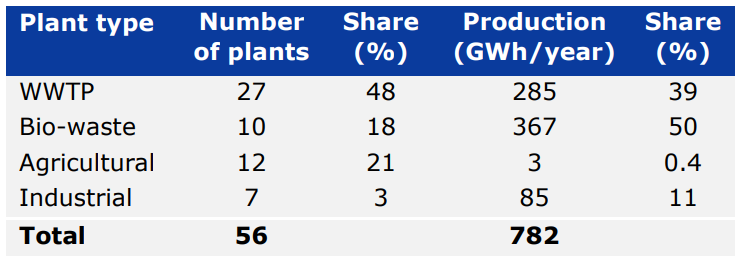
Biogas production in Norway (Norwaste, 2023). Source: IEA Bioenergy.
The policy and financial support system for biogas in Norway consists of:
- investment support for biogas plants,
- economic support to farmers per ton of livestock manure treated by anaerobic digestion,
- tax exemptions when biogas is used as transport fuel.
Fueling stations
The number of fueling stations in Norway has increased rapidly the last few years. The distribution of fueling stations is primarily in the eastern part of Norway, with some biogas fueling hubs in and around some of the larger cities such as Trondheim, Ålesund and Stavanger.
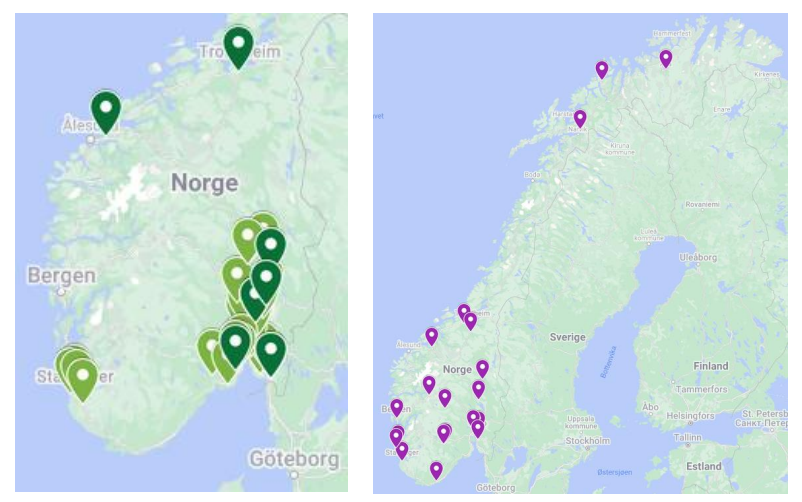
Left: Existing fueling stations in Norway. CBG fueling stations are light green, and LBG or combined CBG&LBG fueling stations are dark green. Right: Planned new fueling stations (in purple) in 2023 to 2025. Maps are from Biogass Norge (2022). Source: IEA Bioenergy.
Most of the fueling stations provide bio-CNG (23 stations), while three provided bio-LNG, and four provided both bio-CNG and bio-LNG. In the next couple of years approximately 20 new fueling stations are planned to be built. The new fueling stations are spread more evenly across the country.
Sweden
There were 284 biogas plants operating in Sweden in 2022, producing in total 2.279 TWh of biogas. Most of the biogas was produced from different types of bio-waste and residues in co-digestion plants (50%) and from sewage sludge in wastewater treatment plants (31%).
There were 71 biomethane upgrading plants in Sweden in 2022 producing 1.47 TWh biomethane. About 546 GWh of this biomethane was injected to the south-western gas network (364 GWh) and in the Stockholm gas grid (182 GWh) via 14 injection sites, the rest was used locally or distributed further by truck to fueling stations. There were also four biomethane liquefaction plants, producing 156 GWh.
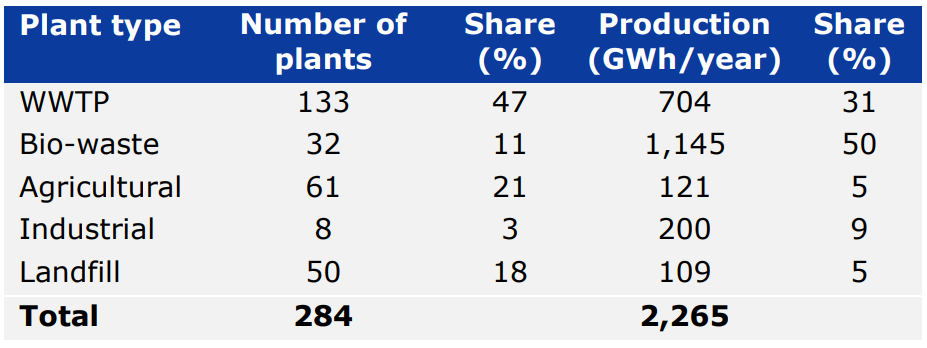
Biogas plants and biogas production in Sweden (Klackenberg, 2023). Source: IEA Bioenergy.
Biomethane in transport
The use of biogas for transportation has increased rapidly over the last 10 years, whereas biogas use for heating has declined. In 2022, 67% of the produced biogas was upgraded and used mainly as transportation fuel, due to a favorable support system.
Currently, the market for methane as a transportation fuel is developed in Sweden but it is highly dependent on greater policy incentives and long-term support systems to take the next step. The use of methane as vehicle fuel increased rapidly up until 2014 and has stabilized at around 1,500 GWh for the last few years. Biomethane accounted for more than 95% of the vehicle gas use in 2019 – 2022.
The Swedish biomethane market is to a large extent off-grid with small local or regional grids or stand-alone biogas gas plants and fueling stations. Today, a large part of the biomethane in Sweden is transported on the road as compressed gas (200/260 bar) and to a small but increasing extent as liquefied gas (LNG and bio-LNG).
The Swedish energy and climate goals push for increased use of renewable energy, especially in transport. The national 2020 goals for renewable energy were reached a few years ago, namely 50% of the total energy utilization and 10% of the energy used in transport.
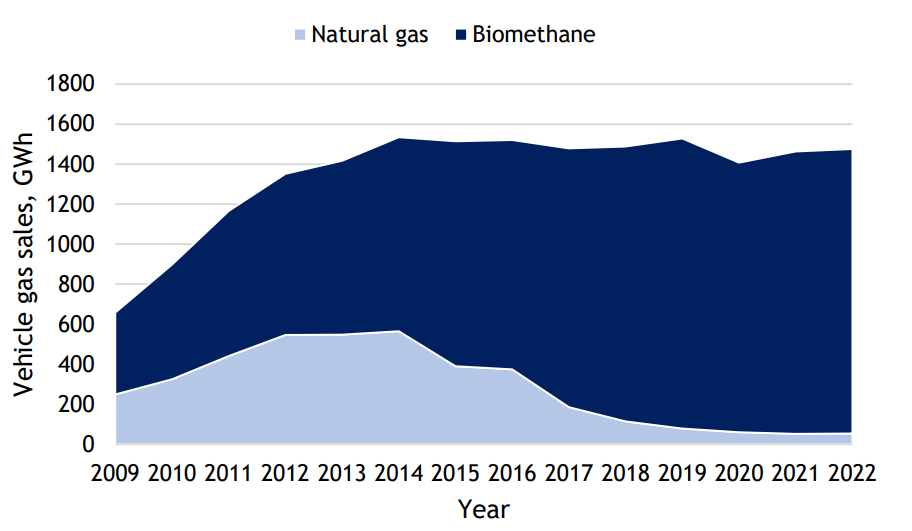
Sales of vehicle gas in Sweden 2009-2022 (Statistics Sweden, 2023). Source: IEA Bioenergy.
Download the full report by IEA Bioenergy (in English)
Overview of the biogas industry in Denmark (on the SAF platform)
Source: IEA Bioenergy.